Locomotive Engineer Darrin Crone provides us with an insight into recent weeks’ work on restoring the great locomotive.
Week commencing 4 November
The week began at the Llangollen Railway Workshops where members of the Sir Nigel Gresley Engineering Team met with Graham Elwood, the Llangollen’s Engineering Manager and his staff. The impression received was that Llangollen are overjoyed to have got the boiler contract and I’m sure they will want the job to be a credit to them.
Back at York, in preparation for its move to Llangollen the dome cover and belly door (manhole) were refitted to the boiler this week. Also in the National Railway Museum‘s North Yard we were visited by Rampart Rail, who assessed the condition of the Support Coach prior to its overhaul. They were asked to pay particular attention to the bogies and electrics. We have been advised to stay with the bogies we have – but they will require refurbishment.
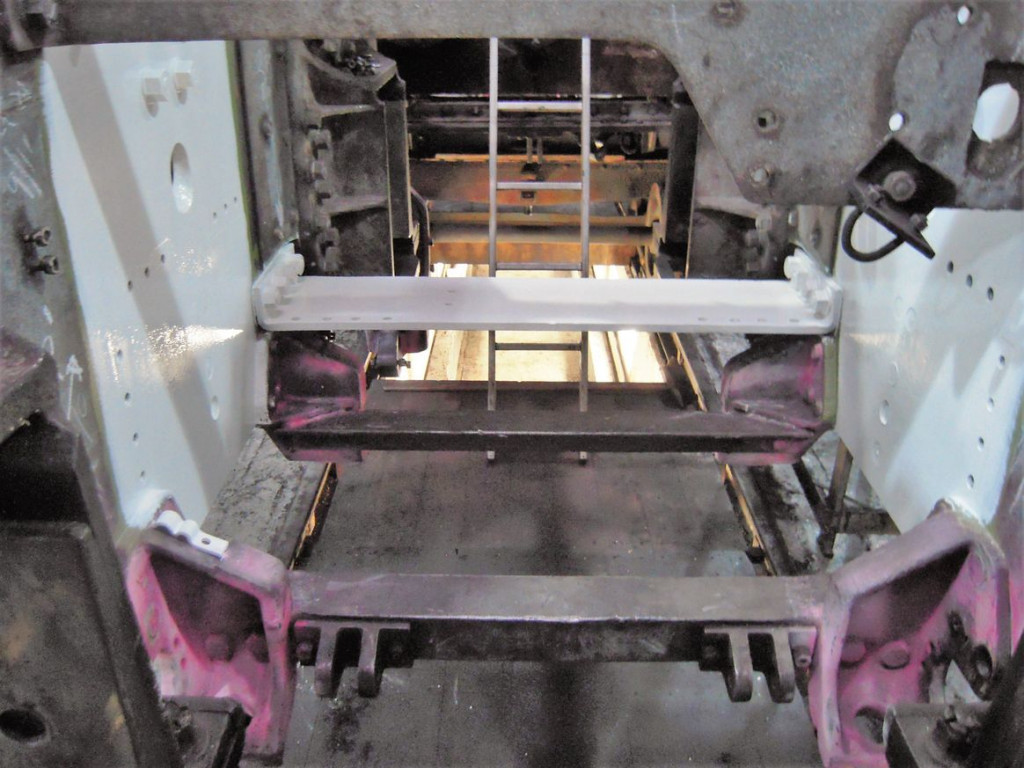
In the workshop the splashers were cleaned down after their repairs and they have now had their first coats of paint. In preparation for refitting the splashers the underneath of the footplating was revisited this week for a further clean.
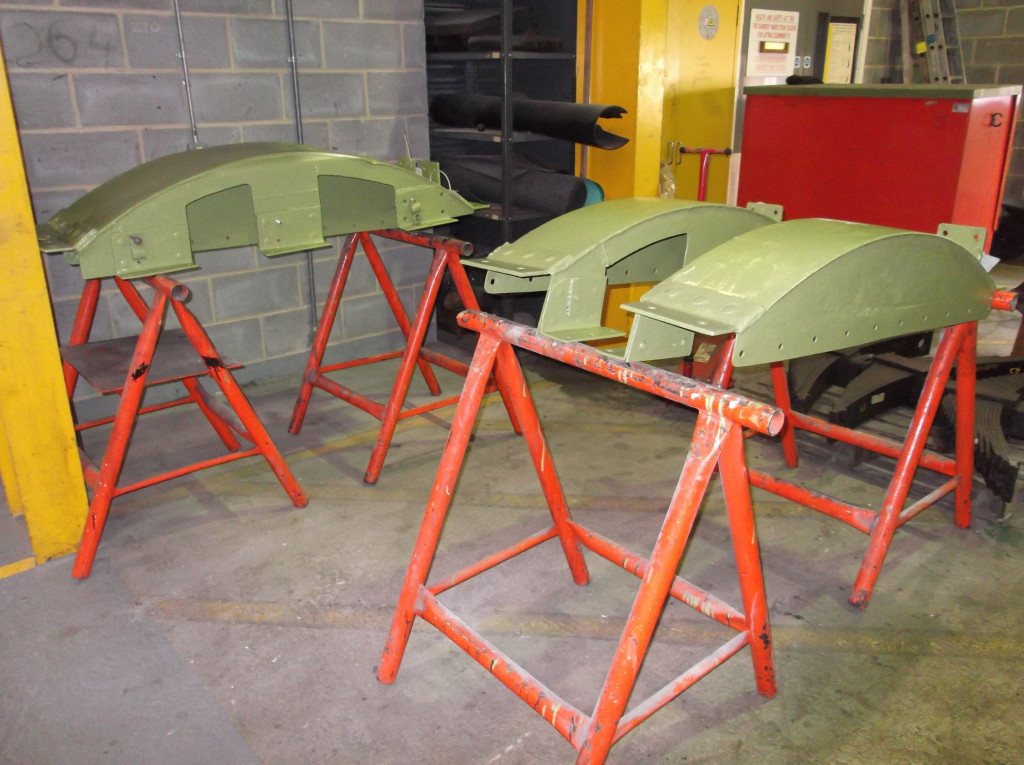
The footplating sections above the cylinders have been removed and spaces below are now being cleaned of the compacted carbon and dirt underneath. The footplating is riveted together so it has not been removed for many an overhaul.
On the right-hand side we have spent some time assessing the condition of the bolts that hold the cylinder to the frames and the saddle at the top leading corner. It was decided that a number of these are life-expired. Some have already been removed but now the footplating is removed the others, newly accessible, can be examined.
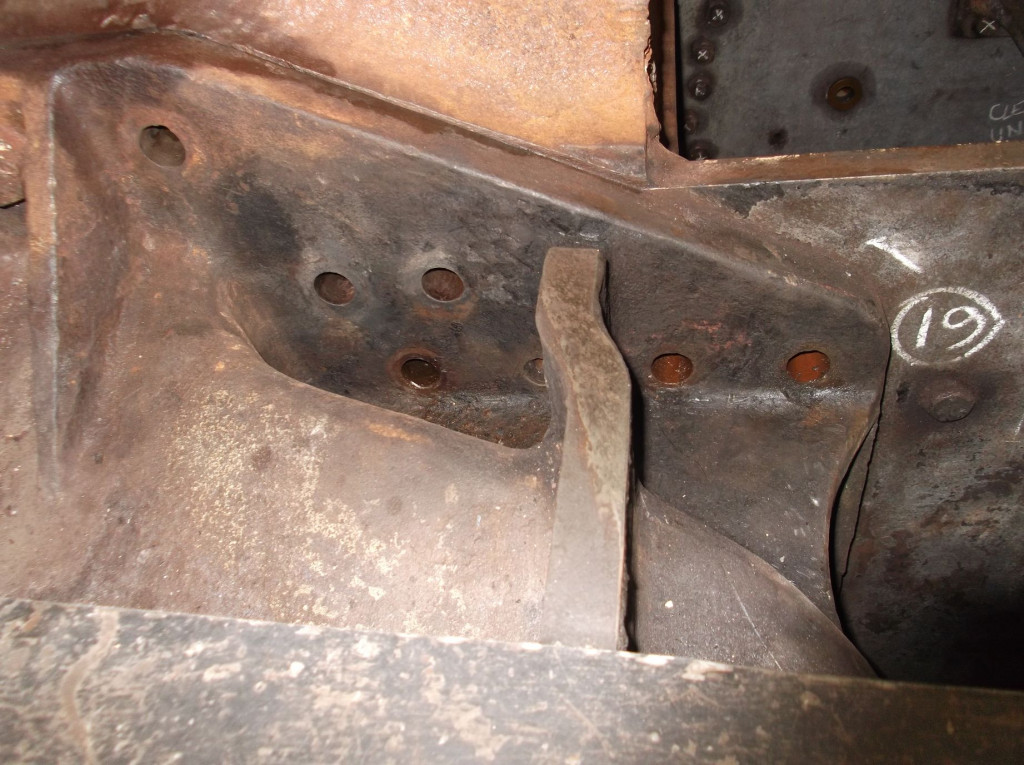
The dye-penetrant inspection of the frames continued this week on the large “+”-shaped stretcher that gives the trailing half of the mainframes much of its strength. The fasteners that hold it on to the frames have been inspected and it has been decided that only one of the fitted bolts requires replacement.

Meanwhile, the saga of the right leading combined spring and brakeshaft bracket continues. After measuring the bracket off the locomotive and finding that it differs from the drawing by a considerable amount it was decided to temporarily remount the bracket back on the frames to take measurements relative to the bracket on the left hand side. The bracket was refitted on Saturday.

Saturday was our regular Junior Volunteer day. They managed to get their hands on the tools and refitted the front drawhook and left-hand buffer in preparation for a shunt planned for this week.
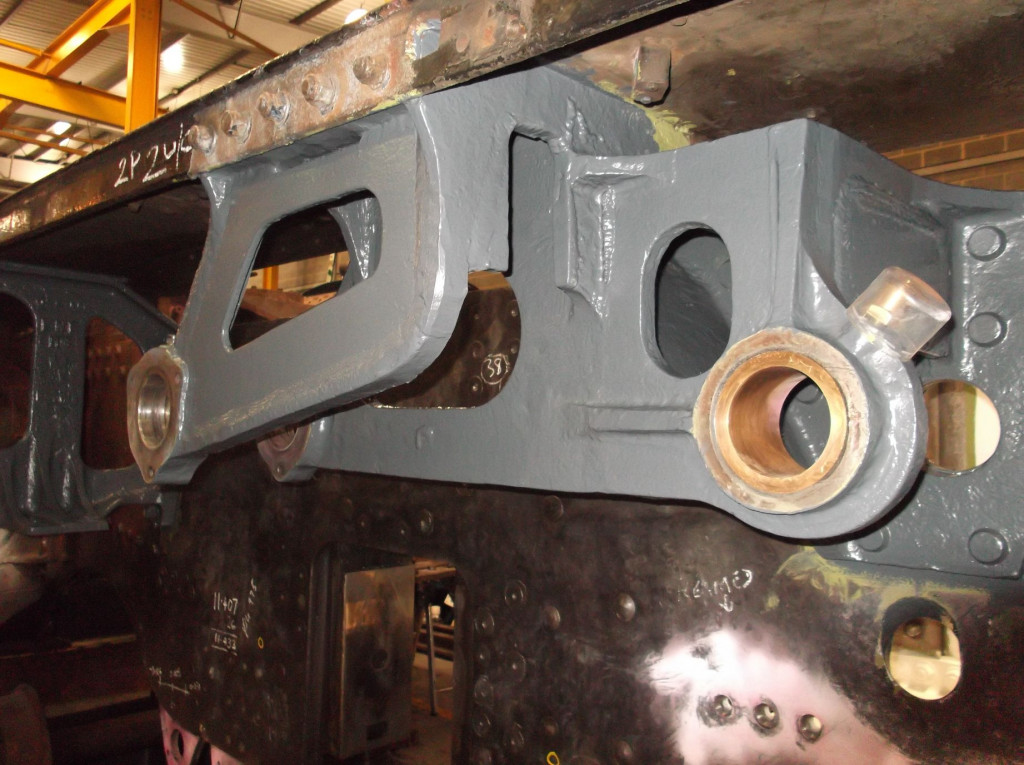
Week commencing 11 November
This week had two highlights. One was very obvious and public, while the other took place in the workshop on the side of the frames away from the main viewing area. These were the transferring of the boiler from its rail wagon onto a road truck for dispatch to Llangollen and the fitting of the first part of the locomotive, signalling the beginning of the reassembly process.
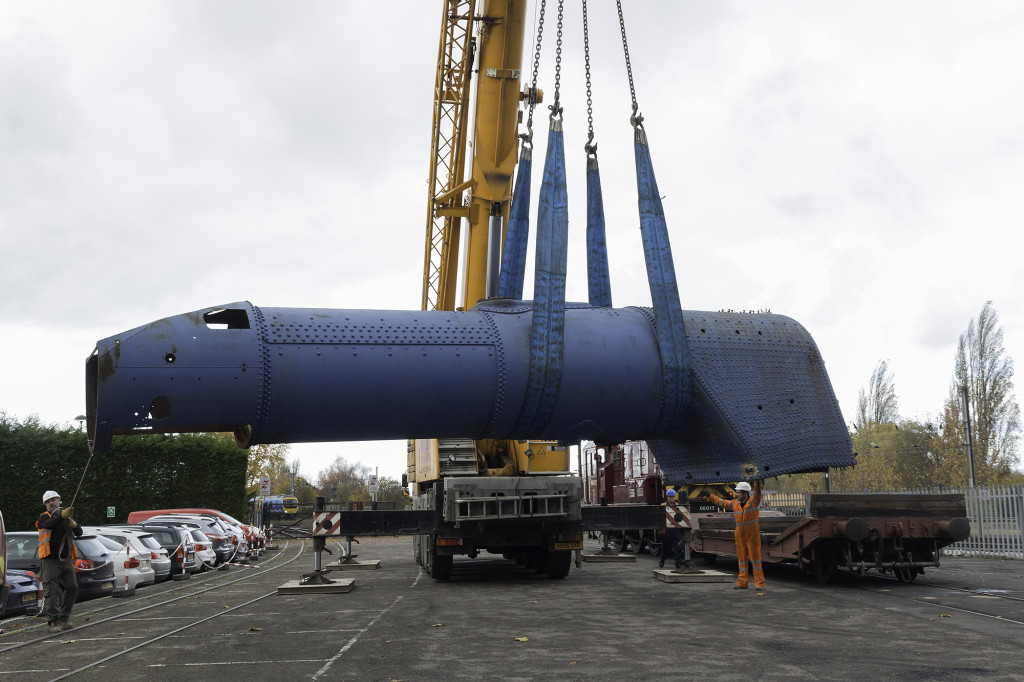
As followers of these overhaul reports will already know, we decided to send the boiler to Llangollen for overhaul. As soon as the boiler contract was awarded and announced, the transport of the boiler was organised. On Wednesday the boiler was lifted off the rail wagon in the west car park of the National Railway Museum by Emsley Crane Hire and put on a Reid Freight low loader. We must thank Noel Hartley and Sarah Dennison of the National Railway Museum for organising access to the yard and shunting the boiler. The operation went off without a hitch. The boiler was loaded onto the low loader and we then used the crane to lift the smokebox door plate into position. It had been removed earlier in the year to allow removal of the superheater and boiler tubes.
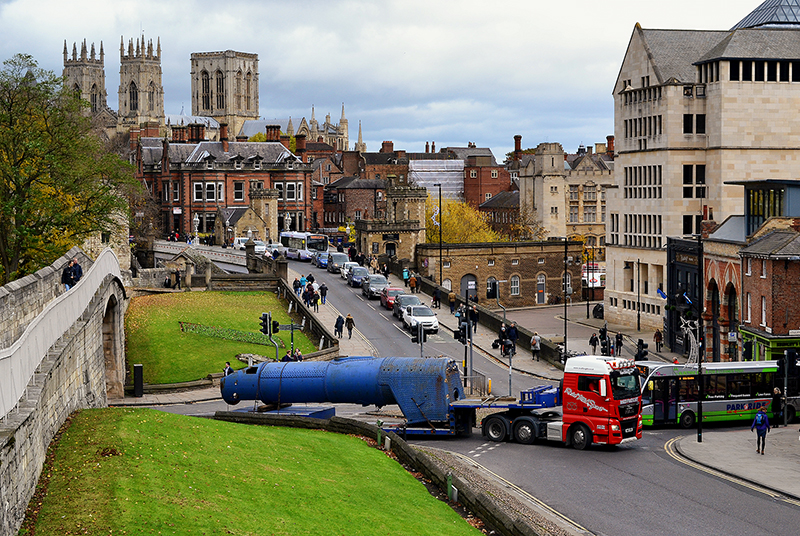
The boiler arrived at Llangollen the same day and was unloaded the next morning, with members of the Engineering Team and our official photographer Trevor Camp in attendance.
Back at York, we progressed the splashers. By the end of the week they were in undercoat. The splasher frame bracket holes, which are very rough, are being cleaned up with a die-grinder and burrs and abrasives. This has to be done without disturbing the position of the brackets. There were a number of loose rivets in the leading splasher footplate brackets so they were removed this week.
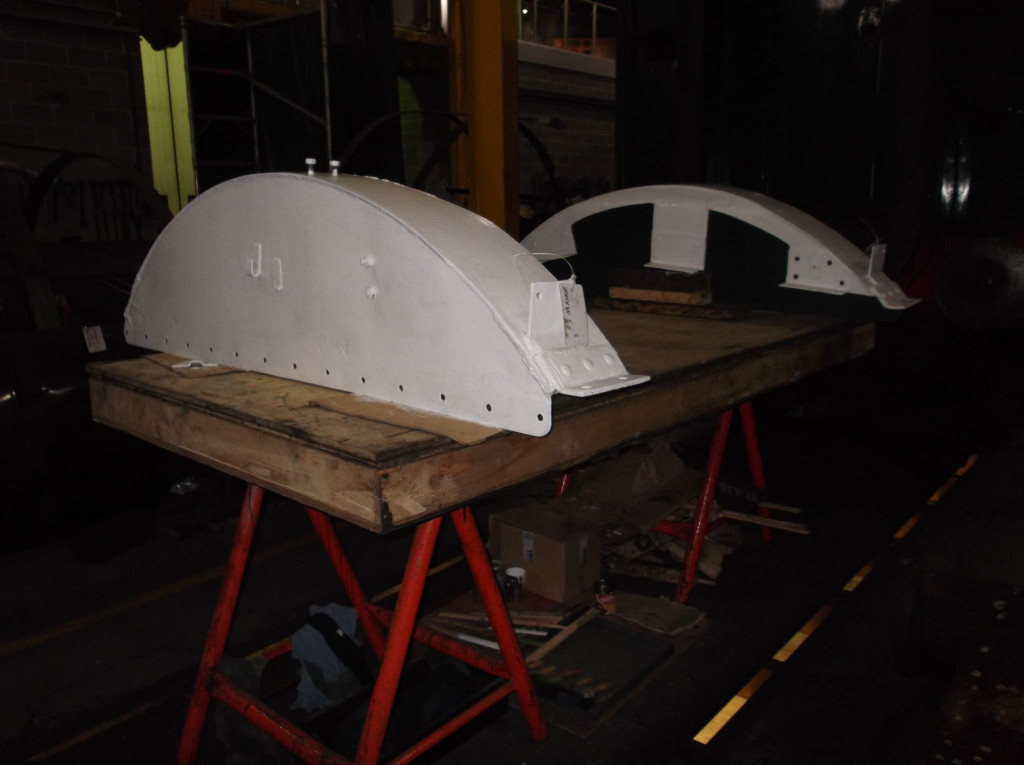
The dye-penetrant inspection of the frames continued this week with the inspection of the large “+”-shaped stretcher in the centre of the frames
There are still some corners below the footplating in need of a final clean. This is not a pleasant job working overhead, less so for one of the taller members of the Engineering Team who took this on. Cleaning the air pump also continued this week. It now needs turning over so that we can access the other side.
In preparation for removing the hornstays for their detailed inspection we have, with permission, used a couple of the National Railway Museum workshop jacks. These are positioned near the centre of the frames and will prevent the frames from sagging, as well as taking the load from the hornstay. Similar jacks are seen in old works photos so it may be that these have been around York North Motive Power Depot (MPD) for some time.

On Saturday our Chief Mechanical Engineer Richard Swales took the final measurement of the leading brakeshaft arrangement and we now have the measurements that will allow the repair of the leading right-hand spring and brakeshaft bracket. After Richard had finished measuring, he then drove home a new fitted bolt that goes through the lubricator bracket, the frames and into the top of the “+” stretcher.
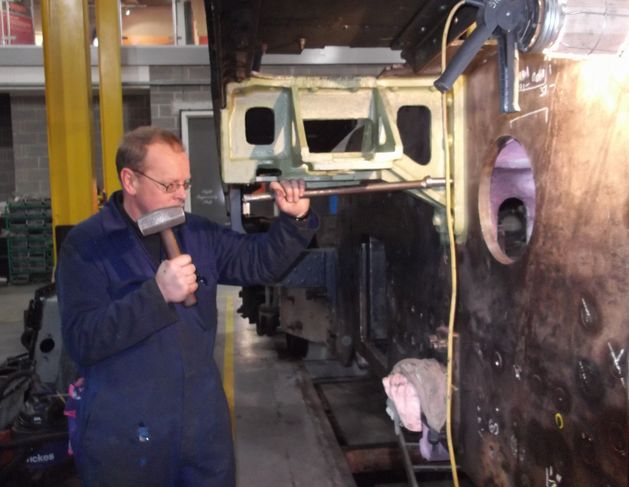
This is the first part to go on to the loco and marks the beginning of the reassembly of the frames. It was one year ago on the 19th November 2015 that the loco entered the National Railway Museum’s York workshop.
Week commencing 18 November
We started the week at Llangollen, where the boiler was delivered to last week. Accompanied by Sir Nigel Gresley’s Richard Swales and Paul Aston, we had a meeting with the representative of our boiler insurer, Llangollen Head of Engineering Graham Elwood and Llangollen boilersmith Graham Beddows.
The boiler in the works at Llangollen.
We worked through the scope of work on which the boiler overhaul tenders were based. The boiler inspector was satisfied with the work that we planned to carry out, and by the end of the week work had started on the removal of stay heads in preparation for the removal of sections of the outer wrapper.
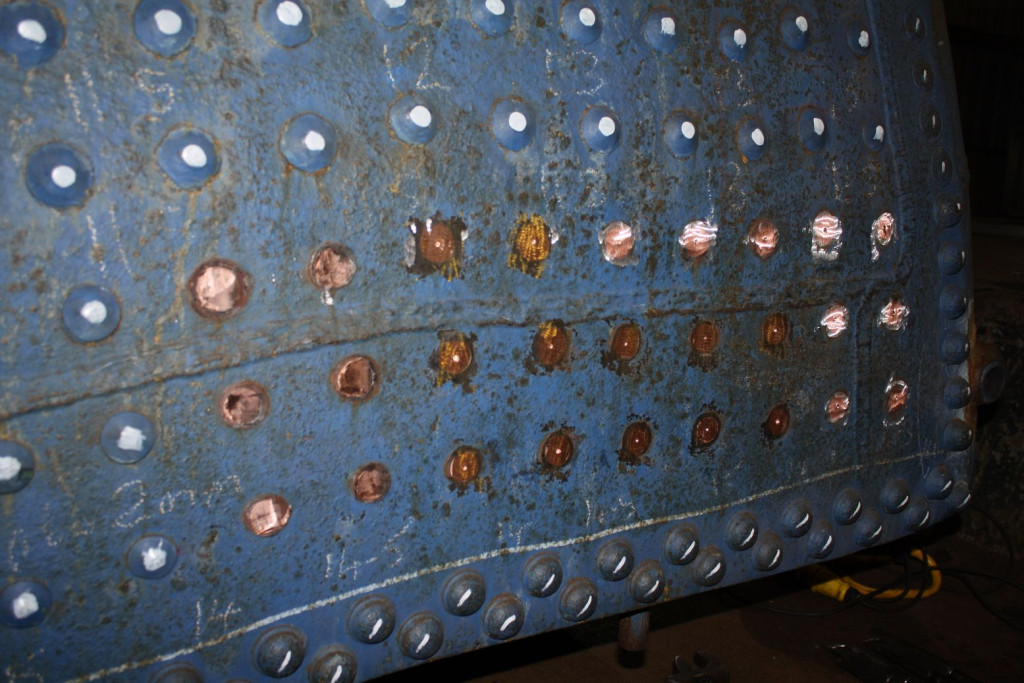
Meanwhile at York, the painting of the splashers continued and they are now receiving gloss top coats. Prior to the refitting of the splashers we need to prepare the area of the footplating on which they fasten. These areas are now receiving a deep clean with those involved expressing amazement at the amount of work involved in getting these areas clean.
The splashers fasten to brackets riveted to the frames and footplating. A number of these rivets have been removed. To allow the rivets to be fitted flush they are countersunk. The countersinks are very rough, but the Engineering Team volunteers have done a great job this week with small grind stones smoothing them out ready for fitting new rivets.
After weeks of threatening to decarbon the steam passages but not getting round to it we had a blitz on decarboning the outside cylinders. Some special scrapers have been made and the right-hand side steam chest is as clean as it’s ever been.

On Friday the last worn-out fitted bolt from the left-hand cylinder flange was removed. The holes in left- and right-hand cylinder flanges have now been measured and new bolts will be manufactured. We have now started to remove a couple of fasteners on the rubbing plate on the loco drawbar which are wasted.
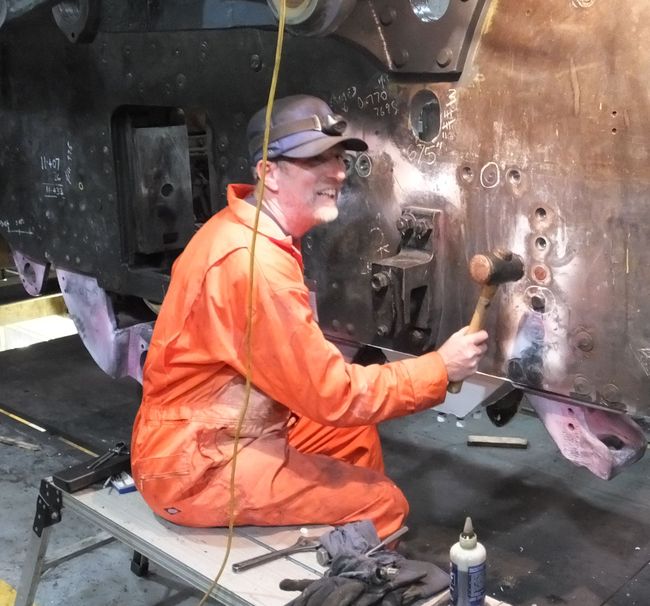
On Saturday the left-hand steam sandbox was refitted. This is the first reconditioned component to be refitted to the loco. We had new fitted bolts made and these were finish-machined to the dimensions of the holes on one of the National Railway Museum’s lathes. We must thank Simon Holroyd and Danny Holmes for permitting us to use this equipment.

The examination and inspection of the loco’s components is very important as it informs our decision to replace, repair or simply reuse parts. From inspections done previously it also gives us the rate of wear of parts from which we can estimate how much further service we can expect from them. Richard Swales, our Chief Mechanical Engineer, has previously measured the valves and liners and the cylinder bores. On Saturday he measured the pistons and from these dimensions we will decide on the repairs necessary to these parts.

Week commencing 25 November
The sandbox fitted last week had its bottom access panel refitted, complete with a new gasket. The bottom studs that the sand trap is fastened to were then die-nutted and the old split pin holes were drilled out. The right-hand steam sandbox was also similarly treated ready for refitting, which was completed on Saturday. After the box was positioned, the holes were reamed and new bolts were fitted. There are still some bolts to fit before this job is completed.
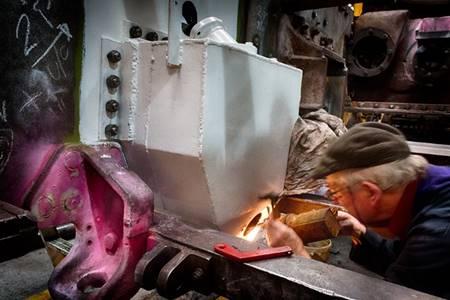
This week the lower nuts on the fireman’s side of the dragbox were removed. The nuts in the top of the dragbox have already been removed and will be replaced. The lower nuts were wasted but, fortunately, most of the bolt threads are still in good condition. However – as with the bolts in the top – corrosion had got to the trailing two, so these were removed. Not an easy job in such an inaccessible location but the Engineering Team volunteers persevered and got them out.

The air supply was restored to the workshop this week after the fault was repaired by the National Railway Museum’s Charlie Bird. This allowed the stripping of parts for repainting and repair to resume. This week the guards around the sand fillers were removed and needle-gunned. After the paint was removed they were welded where they had cracked. They are now ready for repainting. Prior to their refitting, the footplating they are fixed to will require repainting so this area is now being cleaned.
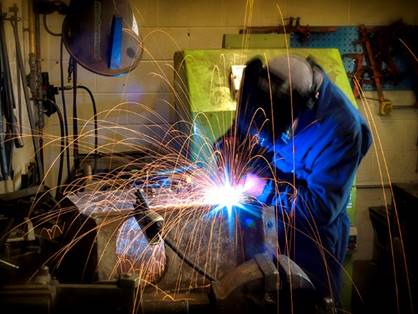
On the subject of painting, the coupled wheel splashers are now finished, as well as the sand filler pipes and flanges. The outside frame brackets on the right-hand side of the loco are now receiving coats of undercoat.
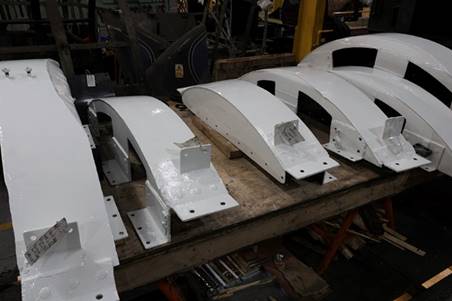
Decarboning of the left-hand steam chest was completed this week and it is now as clean as the right-hand side, which was competed last week. Elsewhere on the frames testing of components continued this week with the inspection of the large “+”-shaped frame stretcher completed.
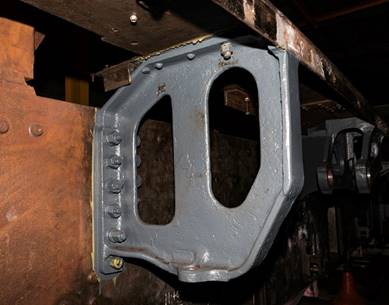
This is the 10th update – you can catch up on the previous posts here.

Visited NRM today. Very impressed with everything. Last time I saw Sir NG was at Grosmont. Looking forward to seeing it steaming again in 2 years time. Hope it can run again with Mallard.